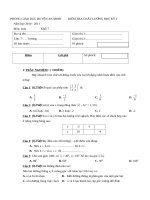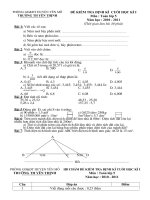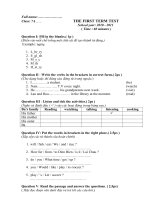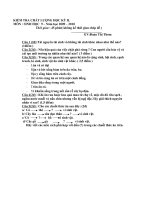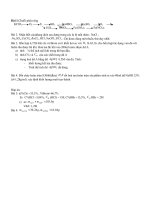Download Đề kiểm tra unit 1,2 tiếng anh 11- có đáp án
Bạn đang xem bản rút gọn của tài liệu. Xem và tải ngay bản đầy đủ của tài liệu tại đây (117.97 KB, 3 trang )
<span class='text_page_counter'>(1)</span><div class='page_container' data-page=1>
<b>REVISION: UNIT 1 + 2 - ENGLISH 9 - 20</b>
<b> 12</b>
<b> -20</b>
<b> 13</b>
<b> </b>
Name:……… Class: 9…
<i><b>I. Multiple choice</b></i>
<b>A. Phonetics:</b>
ó
<i>Choose the word which is pronounced differently from the others.</i>
1.
A. insp
<i><b>i</b></i>
ration
B. com
<i><b>i</b></i>
c
C. ringg
<i><b>i</b></i>
t
D. trop
<i><b>i</b></i>
cal
2.
A. listen
<i><b>ed</b></i>
B. play
<i><b>ed</b></i>
C. want
<i><b>ed</b></i>
D. receiv
<i><b>ed</b></i>
3.
A. p
<i><b>o</b></i>
et
B. symb
<i><b>o</b></i>
l
C. cott
<i><b>o</b></i>
n
D. compuls
<i><b>o</b></i>
ry
4.
A. div
<i><b>i</b></i>
de
B. cl
<i><b>i</b></i>
mate
C. des
<i><b>i</b></i>
gn
D. un
<i><b>i</b></i>
que
5.
A.
<i><b>e</b></i>
ncourage
B. impr
<i><b>e</b></i>
ss
C. r
<i><b>e</b></i>
gion
D.
<i><b>e</b></i>
mbroider
ó
<i>Choose the word that has different tress pattern from the others. </i>
6.
<i>A. primary</i>
<i>B. seperate</i>
<i>C. occasion</i>
<i>D. poet</i>
7.
<i>A. Tamil</i>
<i>B. design</i>
<i>C. material</i>
<i>D. embroider</i>
8.
<i>A. ringgit</i>
<i>B. comprise </i>
<i>C. currency </i>
<i>D. sleeveless</i>
9.
<i>A. minority</i>
<i>B. poetry</i>
<i>C. champagne</i>
<i>D. religion</i>
10.
<i>A. clothing</i>
<i>B. colorful</i>
<i>C. secondary</i>
<i>D. instruction</i>
<b>B. Vocabulary, Grammar and Structure: </b>
1. The _______ religion in Viet Nam is Buddism
<i>A. popular</i>
<i>B. biggest</i>
<i>C. official</i>
<i>D. first</i>
2. Do you think jeans will be _______ ?
<i>A. out of money</i>
<i>B. out of fashion</i>
<i>C. out of date</i>
<i>D. out of time</i>
3.Minh Hanh is a famous _______ in Viet Nam. She has designed lots of styles of clothes.
<i>A. musician</i>
<i>B. designer</i>
<i>C. tennis player</i>
<i>D. taxi driver</i>
4. It’s dangerous ________ in this river.
<i>A. to swim</i>
<i>B. swimming</i>
<i>C. swam</i>
<i>D. swim</i>
5. When it’s cold . My sister always wears a _______ around her neck.
<i>A. shoe</i>
<i>B. scarf</i>
<i>C. sandal</i>
<i>D. belt</i>
6. _______ , Ao dai was frequently worn by both men and women.
<i>A. tradition</i>
<i>B. traditional</i>
<i>C. traditionally</i>
<i>D. traditionalist</i>
7. I _______ that film 12 years ago.
<i>A. watched</i>
<i>B. am watching</i>
<i>C. have watched</i>
<i>D. will watch</i>
8. The word jean comes _______ a kind of material that was made in Europe.
<i>A. at</i>
<i>B. on</i>
<i>C. in</i>
<i>D. from</i>
9. The traditional dress of Japanese women is _______
<i>A. Ao dai</i>
<i>B. Kimono</i>
<i>C. Sari</i>
<i>D. Jean</i>
10. Ha Noi people are very friendly and _______
<i>A. hospitable</i>
<i>B. angry</i>
<i>C. sad</i>
<i>D. afraid </i>
11.
<i>Choose the underlined word or phrase in below sentence that needs correcting.</i>
I’m looking forward to see you soon
<i>A B C D</i>
12. Vietnamese women can continue to wear the
<i><b>unique</b></i>
dress, which is now both traditional and
fashionable. (
<i>Which is similar to the meaning with the underlined word?)</i>
<i>A. one</i>
<i>B. only</i>
<i>C. first</i>
<i>D. a</i>
13. Tom : “Where’s your key?” => Mary : “I don’t know. I _______ it”.
<i>A. lost</i>
<i>B. am lost</i>
<i>C. have lost</i>
<i>D. was lost</i>
14. When Nga was 3 months old, She _______ anytime she was hungry.
<i>A. cried</i>
<i>B. drove</i>
<i>C. ran</i>
<i>D. climbed</i>
15. In the 1990s the worldwide _______ situation got worse.
<i>A. economic</i>
<i>B. economical</i>
<i>C. economist</i>
<i>D. economy</i>
16.
<i><b>Active:</b></i>
We can solve this difficulty.
<i><b>Passive:</b></i>
<i>A.This difficulty is solved. B.This difficulty can solved. C.This difficulty can be solved. D.</i>
<i>ABC correct</i>17. Nowadays many young people restart _______ jeans.
<i>A. wears</i>
<i>B. wear</i>
<i>C. wore</i>
<i>D. wearing</i>
18. Have you seen any elephants on TV _______ ? => Yes, I have.
<i>A. already</i>
<i>B. ever</i>
<i>C. yet</i>
<i>D. since</i>
19. Parents should encourage their children to _______ their traditional family.
</div>
<span class='text_page_counter'>(2)</span><div class='page_container' data-page=2>
20. The rooms _______ every morning.
<i>A. were cleaned</i>
<i>B. have been cleaned </i>
<i>C. will be cleaned</i>
<i>D. are cleaned</i>
21. You want to your new friend to know your name
<i>, you can say: _______.</i>
<i>A. I’m pleased to meet you</i>
<i>B. Let me introduce myself</i>
<i>C. I think I am fine.</i>
<i>D. Hello, Teo.</i>
22. I didn’t go to your birthday party because that day _______
<i>A. I was sick</i>
<i>B. I would be sick</i>
<i>C. I have been sick</i>
<i>D. I like sick</i>
23. _______ ? => I’ve known her for two years.
<i>A. When did you know Lan? B. How did you know Lan? C. How long have you known Lan? D. ABC correct</i>
24.
<i>Nam: </i>
Thank you very much! =>
<i>Quan:</i>
_______.
<i>A. Nothing</i>
<i>B. Good idea</i>
<i>C. Not at all</i>
<i>D. Pretty good</i>
<b>C/</b>
<b> </b>
<b> Read</b>
John Brown is a lecturer. He went to university in 1982, and was one of the ___1___ students at that time.
In 1990, he became professor. He has been a senior lecturer ___2___ then. He is very well-known in his teaching
career. He wrote five ___3___ about education, including a book “How to teach deaf children” in 1995. He used to
___4___ to Thailand, the Philippines, and Viet Nam to give lectures.
1.
<i>A. good</i>
<i>B. better</i>
<i>C. best</i>
<i>D. well</i>
2.
<i>A. since</i>
<i>B. for</i>
<i>C. from</i>
<i>D. at</i>
3.
<i>A. books</i>
<i>B. poems</i>
<i>C. stories</i>
<i>D. novels</i>
4.
<i>A. is</i>
<i>B. are</i>
<i>C. am</i>
<i>D. be</i>
<i><b>III/ Writing</b></i>
<b>A/ Read the passage carefully and answer the questions. </b>
<b>History of clothing</b>
It is not certain when people first started wearing clothes however, anthropologists give estimates that range
between 100,000 to 500,000 years ago. The first clothes were made from natural elements: animal skin and furs,
grasses and leaves, and bones and shells. Clothing was often draped or tied however, simple needles made out of
animal bone provide evidence of sewn leather and fur garments from at least 30,000 years ago.
Before
sewing machines
,
nearly all clothing was local and hand-sewn, there were tailors and seamstresses in
most towns that could make individual items of clothing for customers. After the sewing machine was invented, the
ready-made clothing
industry took off.
1/
Who give estimates that range between 100,000 to 500,000 years ago?
=> _________________________________________________________________________
2/ W
ere the first clothes made from natural elements such as cotton, polyester?
=> _________________________________________________________________________
3/ Did
fur garments come from at least 30,000 years ago?
=> _________________________________________________________________________
4/ What
happened with clothing after the sewing machine was invented?
=> _________________________________________________________________________
<b>B/ Rewrite the sentence, beginning as shown, so that the meaning stays the same.</b>
1/ Teo can’t swim.
<i><b>(Wish sentence)</b></i>
=>
<i>Teo wishes</i>
_______________________________________________________________
2/ I don’t have a new dictionary.
<i><b>(Wish sentence)</b></i>
<b>=> </b>
<i>I wish</i>
___________________________________________________________________
3/ People repaired this computer an hour ago.
<i><b>(Passive voice)</b></i>
=> ________________________________________________________________________
4/ Did someone broke that vase?
<i><b>(Passive voice)</b></i>
=> ________________________________________________________________________
5/ The president has canceled the meeting.
<i><b>(Passive voice)</b></i>
=> ________________________________________________________________________
6/ They are going to build a new hotel in Chu Se next year.
<i><b>(Passive voice)</b></i>
=> ________________________________________________________________________
7/ People speak English in many countries in the world.
<i><b>(Passive voice)</b></i>
=> ________________________________________________________________________
8/ We began driving when I was eighteen.
<i><b>(Present perfect tense)</b></i>
=> We _____________________________________________________________________
<b>-THE </b>
</div>
<span class='text_page_counter'>(3)</span><div class='page_container' data-page=3>
<i><b>I. Multiple choice</b></i>
<b>A. </b>
1
A
6
C
2
C
7
A
3
A
8
B
4
D
9
B
5
B
10
D
<b>B.</b>
<b>C.</b>
1
C
2
A
3
A
4
D
<i><b>III/ Writing</b></i>
<b>A. </b>
1.
<b>A</b>
<b> nthropologists</b>
give estimates that range between 100,000
to 500,000 years
ago.
2.
<b>No</b>
, they weren’t.
3.
<b>Yes</b>
, they did.
4. (
After the sewing machine was invented,) the
ready-made clothing
industry took off.
<b>B.</b>
1. … he could swim.
2. … I had a new dictionary.
3. This computer was repaired an hour ago.
4. Was that vase broken?
5. The meeting has been canceled by the president.
6. A new hotel is going to be built in Chu Se next year.
7. English is spoken in many countries in the world.
8. … have driven/have been driving since I was eighteen.
<b>-THE </b>
END-1
C
13
A
2
B
14
A
3
B
15
A
4
A
16
C
5
B
17
D
6
C
18
C
7
A
19
A
8
D
20
D
9
B
21
B
10
A
22
A
11
C
23
C
</div>
<!--links-->

